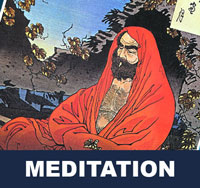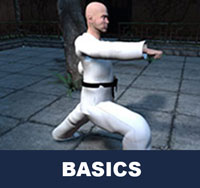Taekwondo 태권도Taekwondo Preschool
Promotion from one geup to the next can proceed rapidly in some schools, since schools often allow geup promotions every two, three, or four months. Students of geup rank learn the most basic techniques first, and then move on to more advanced techniques as they approach first dan. Many of the older and more traditional schools often take longer to allow students to test for higher ranks than newer, more contemporary schools, as they may not have the required testing intervals. View Taekwondo belt levels »

Modern definitions and Western models
The term meditation refers to a broad variety of practices (much like the term sports) that includes techniques designed to promote relaxation, build internal energy or life force (qi, ki, prana, etc.) and develop compassion, love, patience, generosity and forgiveness.
Definitions and Scope
As early as 1971, Claudio Naranjo noted that "The word 'meditation' has been used to designate a variety of practices that differ enough from one another so that we may find trouble in defining what meditation is." There remains no definition of necessary and sufficient criteria for meditation that has achieved universal or widespread acceptance within the modern scientific community, as one study recently noted a "persistent lack of consensus in the literature" and a "seeming intractability of defining meditation".
In popular usage, the word "meditation" and the phrase "meditative practice" are often used imprecisely to designate broadly similar practices, or sets of practices, that are found across many cultures and traditions.
Some of the difficulty in precisely defining meditation has been the need to recognize the particularities of the many various traditions. There may be differences between the theories of one tradition of meditation as to what it means to practice meditation. The differences between the various traditions themselves, which have grown up a great distance apart from each other, may be even starker. To accurately define "what is meditation" has caused difficulties for modern scientists. Scientific reviews have proposed that researchers attempt to more clearly define the type of meditation being practiced in order that the results of their studies be made clearer.
Taylor noted that to refer only to meditation from a particular faith (e.g., "Hindu" or "Buddhist") ... is not enough, since the cultural traditions from which a particular kind of meditation comes are quite different and even within a single tradition differ in complex ways. The specific name of a school of thought or a teacher or the title of a specific text is often quite important for identifying a particular type of meditation
The table shows several definitions of meditation that have been used by influential modern reviews of research on meditation across multiple traditions. Within a specific context, more precise meanings are not uncommonly given the word "meditation". For example, "meditation" is sometimes the translation of meditatio in Latin. Meditatio is the third of four steps of Lectio Divina, an ancient form of Christian prayer. "Meditation" also refers to the second of the three steps of Yoga in Patanjali's Yoga Sutras, a step called dhyāna in Sanskrit. Meditation refers to a mental or spiritual state that may be attained by such practices, and also refers to the practice of that state.
This article mainly focuses on meditation in the broad sense of a type of discipline, found in various forms in many cultures, by which the practitioner attempts to get beyond the reflexive, "thinking" mind (sometimes called "discursive thinking" or "logic") into a deeper, more devout, or more relaxed state. The terms "meditative practice" and "meditation" are mostly used here in this broad sense. However, usage may vary somewhat by context – readers should be aware that in quotations, or in discussions of particular traditions, more specialized meanings of "meditation" may sometimes be used (with meanings made clear by context whenever possible).
Western Typologies
Ornstein noted that "Most techniques of meditation do not exist as solitary practices but are only artificially separable from an entire system of practice and belief." This means that, for instance, while monks engage in meditation as a part of their everyday lives, they also engage the codified rules and live together in monasteries in specific cultural settings that go along with their meditative practices. These meditative practices sometimes have similarities (often noticed by Westerners), for instance concentration on the breath is practiced in Zen, Tibetan and Theravadan contexts, and these similarities or "typologies" are noted here.
Progress on the "intractable" problem of defining meditation was attempted by a recent study of views common to seven experts trained in diverse but empirically highly studied (clinical or Eastern-derived) forms of meditation. The study identified "three main criteria... as essential to any meditation practice: the use of a defined technique, logic relaxation, and a self-induced state/mode. Other criteria deemed important involve a state of psychophysical relaxation, the use of a self-focus skill or anchor, the presence of a state of suspension of logical thought processes, a religious/spiritual/philosophical context, or a state of mental silence." However, the study cautioned, "It is plausible that meditation is best thought of as a natural category of techniques best captured by 'family resemblances'... or by the related 'prototype' model of concepts."

In modern psychological research, meditation has been defined and characterized in a variety of ways; many of these emphasize the role of attention.
In the West, meditation is sometimes thought of in two broad categories: concentrative meditation and mindfulness meditation. These two categories are discussed in the following two paragraphs, with concentrative meditation being used interchangeably with focused attention and mindfulness meditation being used interchangeably with open monitoring,
Direction of mental attention... A practitioner can focus intensively on one particular object (so-called concentrative meditation), on all mental events that enter the field of awareness (so-called mindfulness meditation), or both specific focal points and the field of awareness.
One style, Focused Attention (FA) meditation, entails the voluntary focusing of attention on a chosen object. The other style, Open Monitoring (OM) meditation, involves non-reactive monitoring of the content of experience from moment to moment.
Other typologies have also been proposed, and some techniques shift among major categories.
Evidence from neuroimaging studies suggests that the categories of meditation, defined by how they direct attention, appear to generate different brainwave patterns. Evidence also suggests that using different focus objects during meditation may generate different brainwave patterns.
Definitions or Characterizations of Meditation:
Examples from Prominent Reviews
Walsh & Shapiro (2006) - "[M]editation refers to a family of self-regulation practices that focus on training attention and awareness in order to bring mental processes under greater voluntary control and thereby foster general mental well-being and development and/or specific capacities such as calm, clarity, and concentration"
Cahn & Polich (2006) - "[M]editation is used to describe practices that self-regulate the body and mind, thereby affecting mental events by engaging a specific attentional set.... regulation of attention is the central commonality across the many divergent methods"
Jevning et al. (1992) - "We define meditation... as a stylized mental technique... repetitively practiced for the purpose of attaining a subjective experience that is frequently described as very restful, silent, and of heightened alertness, often characterized as blissful"
Goleman (1988) - "the need for the meditator to retrain his attention, whether through concentration or mindfulness, is the single invariant ingredient in... every meditation system"

Related Articles
Meditation is a practice in which an individual trains the mind or induces a mode of consciousness. The practice has a calming effect and directs awareness inward until pure awareness is achieved, described as being awake inside without being aware of anything except awareness itself. Meditation is often used to clear the mind and ease many health issues, such as high blood pressure, depression, and anxiety. View Meditation »
- History of Mediation - the history is intimately bound up with the religious context within which it was practiced. Around the 6th to 5th centuries BCE, other forms of meditation developed in Taoist China and Buddhist India.
- Definition of Meditation - refers to practices that includes techniques designed to promote relaxation, build internal energy or life force and develop compassion, love, patience, generosity and forgiveness. A particularly ambitious form of meditation aims at effortlessly sustained single-pointed concentration single-pointed analysis, meant to enable its practitioner to enjoy an indestructible sense of well-being while engaging in any life activity.
- Mediation Postures - various meditative postures have been used in meditation such as sitting cross-legged, sitting on a chair, and standing postures. In taekwondo, one can meditate in several stances ( 서기 sogi ) including the Back Stance ( 뒷굽이 dwi-kubi ) and the Crane Stance ( 학다리서기 hakdari-sogi ). One should feel comfortable and rest in a simple and unstrained way.
- Qigong - practice of aligning body, breath, and mind for health, meditation, and martial arts training. With roots in Chinese medicine, philosophy, and martial arts, qigong is traditionally viewed as a practice to cultivate and balance Qi (chi) or what has been translated as life energy.

Taekwondo Basics
Here is where you can learn more about Taekwondo 태권도. Knowing the fundamental basics is very important for your learning path as you build your skills and knowledge. There are certain rules that need to be followed to show respect to the master ( 사범님 sabeomnim ), the instructors ( 교사님 gyosannim ), other practitioners and to the martial arts. They vary between schools but many have similar rules and guidelines. For more information View Taekwondo Basics »
There are five tenets defined in the International Taekwondo Federation (ITF) and several more in World Taekwondo (WT).
Indomitable Spirit ( 백절불굴 baekjul-boolgool ): "To have indomitable spirit means to have the courage to stand up for what you believe in, no matter what odds you are up against, and to always give 100% effort in whatever you do." View Taekwondo Tenets »
RESOURCES
This article uses material from the Wikipedia article "Meditation", which is released under the Creative Commons Attribution-Share-Alike License 3.0.





























